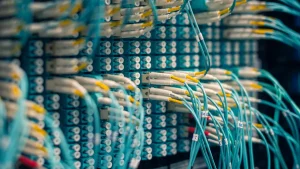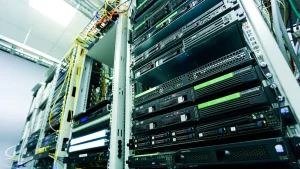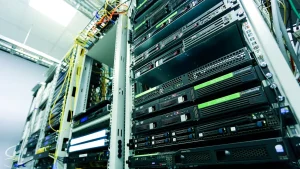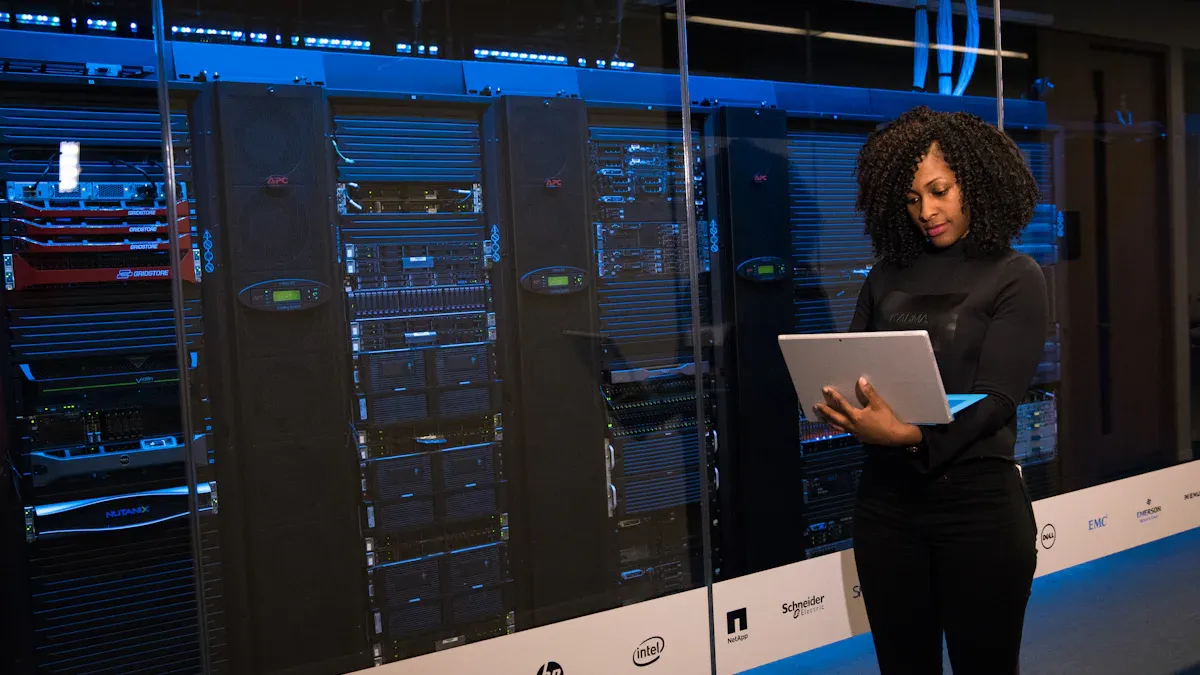
The global PDU market reached $9.1 billion in 2024.
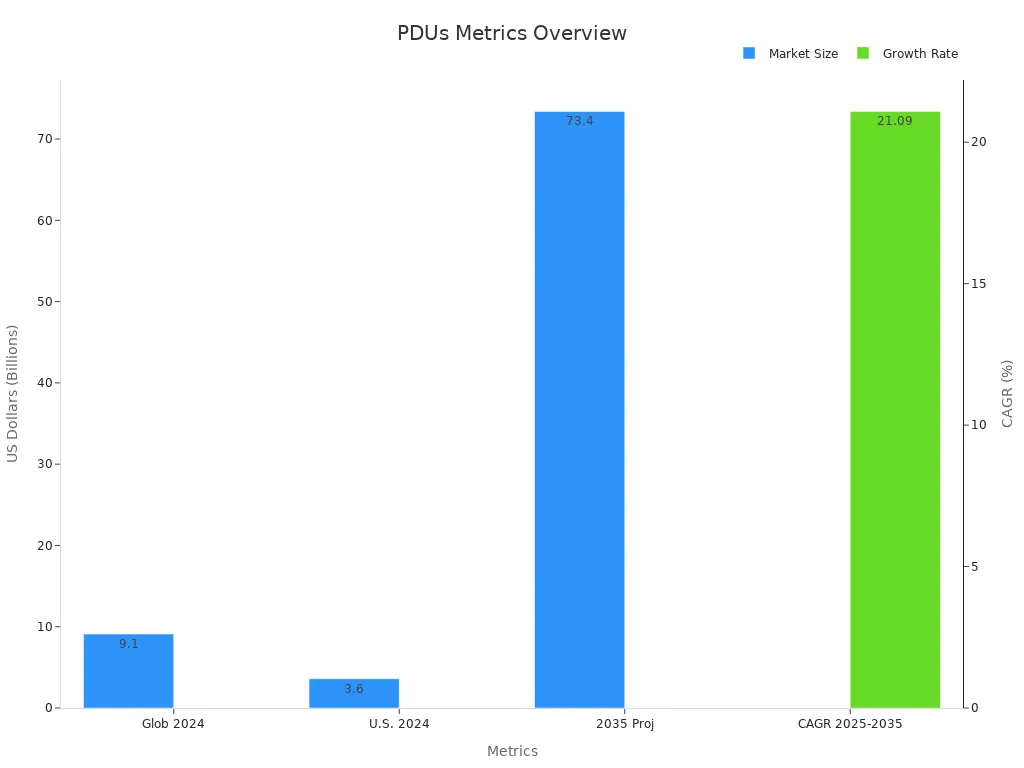
Data center managers often reject energy-saving features if they risk uptime. Security and energy efficiency play a major role in reliability decisions.
Key Takeaways
- Choose PDUs with scalable power capacity and advanced monitoring to support current needs and future growth while improving energy efficiency.
- Use PDUs with real-time monitoring and remote management to reduce downtime, optimize power use, and enable quick responses to issues.
- Invest in high-quality, energy-efficient PDUs with strong security and redundancy features to ensure reliable operation and lower long-term costs.
PDU Power Capacity
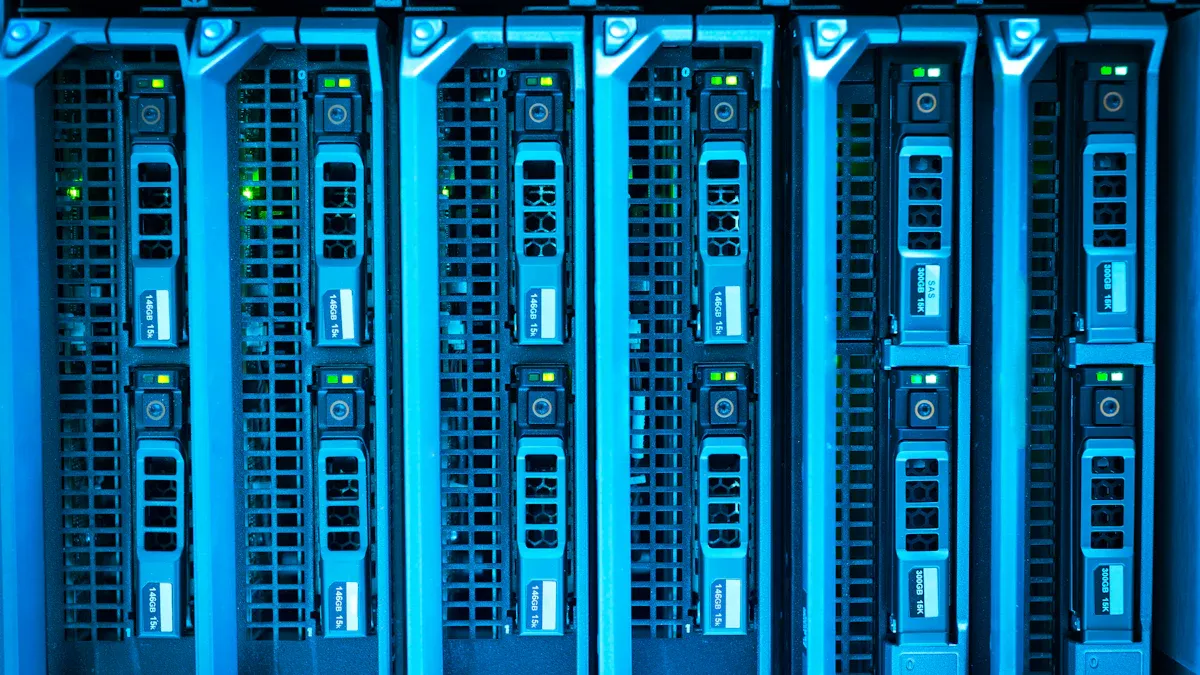
Types of Power Capacity
Data centers require different power capacities based on their size and workload. Power Distribution Units (PDUs) come in a range of capacities, from basic models for small server rooms to high-capacity units for hyperscale facilities. Modular PDUs allow operators to expand capacity as needed, which supports future growth and prevents costly replacements. Many modern PDUs offer advanced features such as outlet-level control, real-time energy monitoring, and compatibility with Data Center Infrastructure Management (DCIM) systems. High build quality and certifications like ISO9001, UL, and RoHS ensure safety and reliability in demanding environments.
- The global data center PDU market is projected to grow from $2.3 billion in 2023 to $4.5 billion by 2032.
- Modular PDUs enable capacity expansion without full replacement.
- Advanced PDUs include features like remote monitoring and environmental sensors.
- Safety features such as circuit breakers and locking outlets are standard in professional models.
Importance for High-Density Racks
High-density racks house more servers and require greater power capacity. Modular PDUs, such as the ESTEL High-Density Rack PDU, provide flexibility and support for these environments. Scalability is critical, as it allows data centers to add more equipment without overloading circuits. Operators benefit from robust power capacity and customization options, which help maintain uptime and support future technology upgrades.
Impact on Data Center Performance
Power capacity directly affects data center performance. As data centers grow, their energy use increases rapidly. The table below shows how electricity consumption has changed over time:
| Year | U.S. Data Center Electricity Use (TWh) | % of U.S. Total |
|---|---|---|
| 2014 | 60 | 1.9% |
| 2018 | 76 | 1.9% |
| 2023 | 176 | 4.4% |
| 2028 | 325-580 (projected) | 6.7%-12% |
Operators must choose PDUs with enough capacity to handle current and future workloads. Improved power infrastructure, such as efficient PDUs, helps reduce energy waste and supports better Power Usage Effectiveness (PUE), which measures how efficiently a data center uses energy.
PDU Monitoring and Control
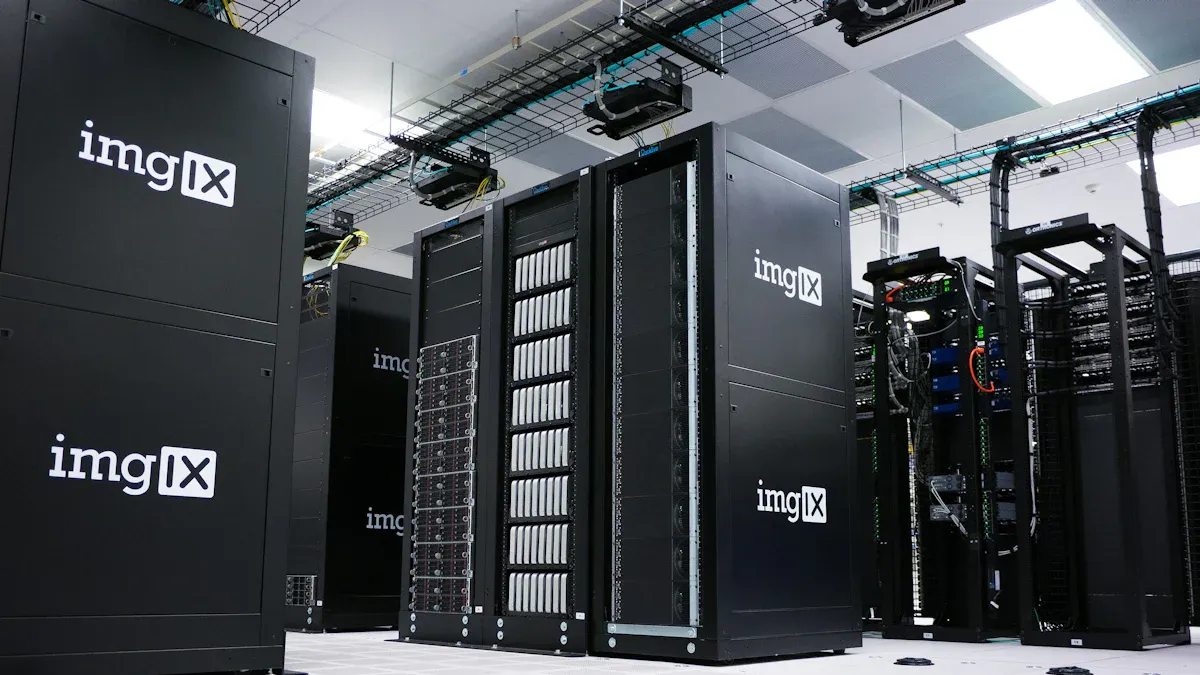
Real-Time Monitoring Features
Real-time monitoring features help data centers track power consumption and environmental conditions. These systems provide immediate alerts when power spikes or irregularities occur, which helps prevent downtime and equipment damage. Operators can view key electrical parameters such as current, voltage, wattage, and frequency. Outlet-level monitoring identifies devices that use too much power or sit idle, allowing for better load balancing. Managed PDUs with these features support energy efficiency by reducing waste and supporting sustainability goals. For example, the Yosun PDUYS1508-WN-SPS enabled targeted energy optimizations, leading to an 18% reduction in power consumption and saving about $120,000 each year. Proactive alerts also help prevent circuit overloads, extending equipment lifespan.
- Tracks power and environmental data in real time
- Sends alerts for threshold breaches
- Supports load balancing and energy savings
- Enables trend analysis and capacity planning
Remote Management Capabilities
Remote management allows IT teams to control and troubleshoot equipment from any location. This capability reduces the need for manual inspections and speeds up response times. Remote monitoring systems, often combined with AI and machine learning, detect equipment issues before they cause downtime. These systems trigger alarms and provide forensic insights, which help prevent outages. Albireo Energy uses Electrical Power Monitoring Systems (EPMS) to capture real-time and historical data, enabling proactive maintenance and early detection of failures. The Z-ATS Micro device, for example, switches power sources within 14 milliseconds to maintain continuous power.
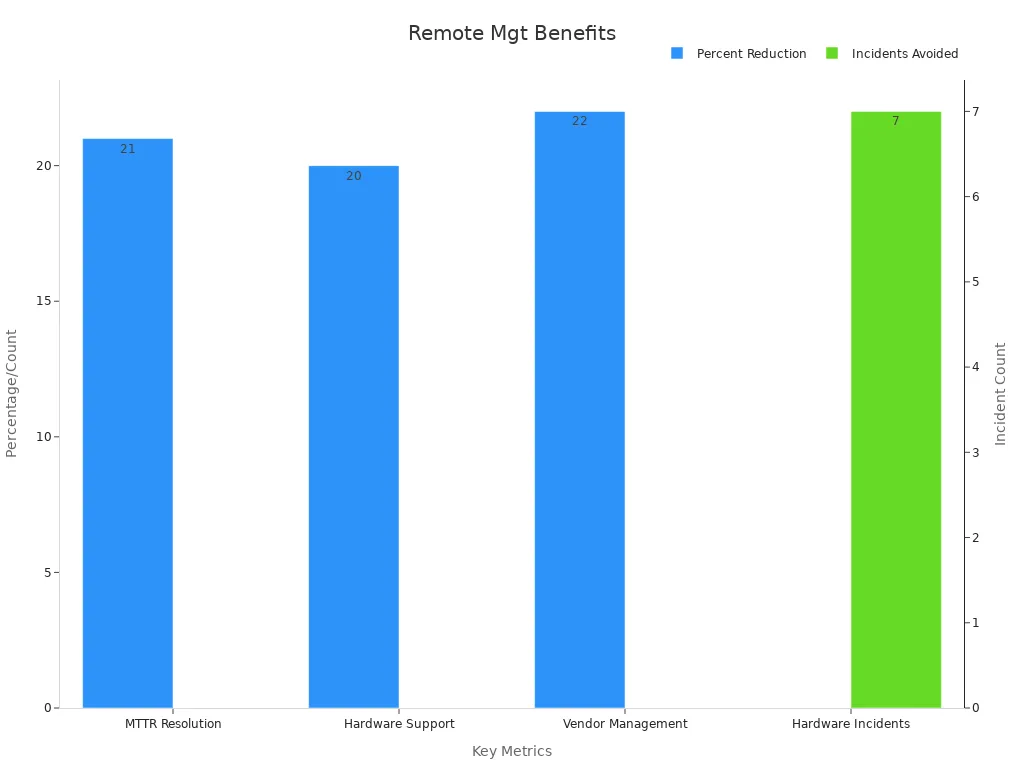
| Metric | Impact on Downtime and Support Efficiency |
|---|---|
| 21% reduction in mean time to resolve hardware outages | Faster incident resolution reduces downtime significantly |
| Avoidance of 7 hardware incidents/outages annually | Proactive monitoring prevents multiple outages each year |
| 20% reduction in time spent on hardware support tasks | More efficient support frees IT staff to focus on other tasks |
| 22% reduction in time spent on vendor relationship management | Simplifies management, indirectly reducing downtime risks |
Data Analytics and Reporting
Data analytics and reporting tools in modern PDUs provide valuable insights for data center operators. These tools track historical and real-time data, supporting trend analysis and capacity planning. Operators can identify high energy-consuming equipment and make targeted improvements. Detailed energy consumption data also supports charge-back models, promoting accountability. Smart PDUs help calculate Power Usage Effectiveness (PUE), a key metric for energy efficiency. Companies like eBay have achieved up to a 50% reduction in operating costs through detailed energy monitoring. Real-time alerts and proactive notifications minimize downtime by enabling early detection of potential issues.
PDU Energy Efficiency
Efficiency Ratings and Certifications
Manufacturers design modern PDUs to help data centers save energy and reduce carbon emissions. Many models include advanced energy monitoring, which tracks power use at the circuit breaker, inlet, and outlet levels. This real-time data helps operators plan power capacity and keep equipment running efficiently. While there are no universal efficiency ratings for PDUs, companies often follow compliance certifications for safety and reliability. Some organizations also focus on professional training in energy management and carbon reduction. These efforts ensure that staff use best practices to lower energy consumption and maintain operational standards.
Smart PDUs often support load balancing, power capping, and even renewable energy integration. These features help data centers optimize power use and meet sustainability goals.
Power Usage Effectiveness (PUE)
Power Usage Effectiveness, or PUE, measures how efficiently a data center uses energy. Operators calculate PUE by dividing the total facility energy by the energy used by IT equipment. A lower PUE means better energy efficiency. PDUs with advanced monitoring make it easier to track and improve PUE. They provide detailed reports on power consumption, which helps managers find areas to save energy. Many data centers use this information to set targets and measure progress toward efficiency.
Cost Savings and Sustainability
Energy-efficient PDUs help data centers lower electricity bills and reduce their environmental impact. By using real-time monitoring and smart controls, operators can spot waste and fix problems quickly. Some PDUs even forecast power needs using IoT technology, which prevents overuse and supports long-term savings. These improvements not only cut costs but also help companies meet sustainability targets. Data centers that invest in efficient power distribution see benefits in both their budgets and their carbon footprints.
PDU Reliability and Uptime
Build Quality and Redundancy
High build quality and redundancy play a key role in keeping data centers running. Strong construction and backup systems help prevent failures. The Uptime Institute’s Tier Classification System shows how redundancy affects uptime:
| Data Center Tier | Redundancy Level | Expected Uptime (%) | Maximum Downtime per Year | Typical Customers |
|---|---|---|---|---|
| Tier I | No redundancy | 99.671 | Up to 28.8 hours | Small businesses, start-ups |
| Tier II | Partial power and cooling | 99.741 | Up to 22 hours | Small to medium businesses (SMB) |
| Tier III | N+1 redundancy, multiple power and cooling paths | 99.982 | Up to 1.6 hours | Growing and large businesses |
| Tier IV | 2N or 2N+1, fully fault tolerant, no single points of failure | 99.995 | Up to 26.3 minutes | Government entities, large global enterprises |
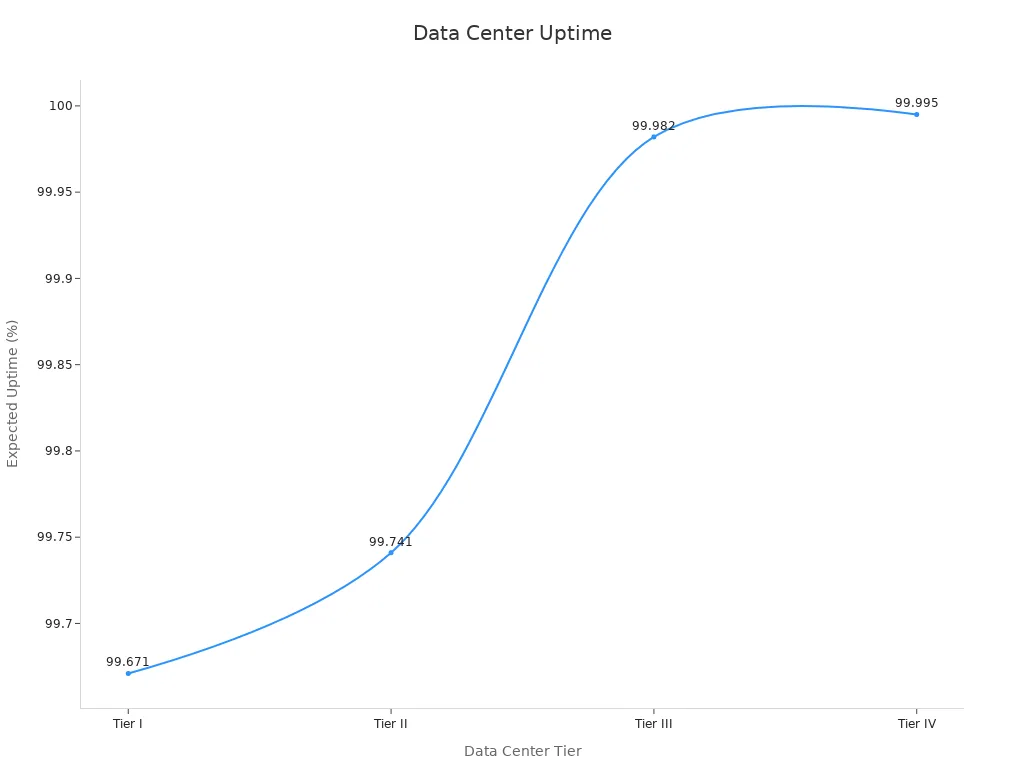
Redundant power supplies, cooling, and fire-prevention systems help data centers reach “five nines” uptime. Operators use centralized management to monitor these systems and respond quickly to problems.
Surge Protection and Failure Prevention
Surge protection devices (SPDs) help prevent costly failures and downtime. They protect sensitive electronics from power surges and lightning strikes. Key facts include:
- Unplanned downtime costs Fortune Global 500 companies about $1.5 trillion each year, much from surge-related failures.
- Power surges cost US companies over $80 billion annually.
- Surges can destroy equipment, cause data loss, and create safety risks.
- Type 2 SPDs protect low voltage systems, while Type 1 SPDs guard against lightning surges.
- Lightning strikes cause millions of outages each year in the US.
A PDU with built-in surge protection helps avoid these risks and keeps operations stable.
Maintenance and Support
Reliable maintenance and support keep data centers running smoothly. Operators choose PDUs with features like remote monitoring, automatic power transfer, and robust construction. These features allow for repairs and upgrades without shutting down equipment. Real-time monitoring helps spot problems early, so teams can fix them before they cause downtime. Quick support and easy maintenance help data centers meet high uptime goals.
PDU Compatibility and Integration
Rack and Equipment Compatibility
Data centers use many types of racks and devices. Operators must select PDUs that fit different rack sizes and support a wide range of equipment. Some PDUs offer adjustable mounting brackets and multiple outlet types. This flexibility helps teams install new servers or network devices without changing the power setup. Compatibility with both legacy and modern hardware ensures smooth upgrades and reduces downtime.
Tip: Always check the PDU’s outlet configuration and mounting options before purchase to avoid installation issues.
Integration with DCIM and IT Systems
Modern data centers rely on integration between PDUs, DCIM platforms, and IT systems. This integration gives operators real-time visibility into power use and environmental conditions. Reports show that when PDUs work with DCIM systems, operational costs drop by 20%, and downtime can fall by up to 25%. Power Usage Effectiveness (PUE) also improves, sometimes reaching as low as 1.2. One data center improved its Data Center Infrastructure Efficiency (DCiE) from 0.6 to 0.8 after linking its Building Automation System with DCIM and making energy-saving changes. Intelligent PDUs with telemetry and remote control features help automate tasks and support better decision-making.
Future-Proofing for New Technologies
Technology in data centers changes quickly. Operators need PDUs that support new standards and can handle higher power loads. Many intelligent PDUs now include remote firmware updates, lithium-ion backup, and open interfaces for easy integration with future systems. These features help data centers adapt to new equipment and higher densities without major changes.
- Choose PDUs with API support for automation
- Look for models that allow remote updates
- Select units compatible with both current and emerging rack designs
PDU Scalability and Flexibility
Modular and Custom PDU Options
Data centers often choose modular and custom power solutions to support growth and changing needs. Modular PDUs allow operators to add up to ten units for expansion. This design supports infrastructure growth without causing disruptions or downtime. Custom PDUs address unique challenges, such as extreme temperatures or high surge ratings. They also provide precise load balancing for different industries. Operators can select features that match their environment, improving reliability and efficiency.
| Feature | Benefit |
|---|---|
| Modular Design | Supports adding multiple PDUs (up to ten) for expansion |
| Scalability | Enables infrastructure growth without causing disruptions |
| Operational Efficiency | Maintains efficiency during expansion phases |
Note: Modular PDUs help data centers grow quickly and keep operations running smoothly.
Expansion Capabilities
Modern PDUs support rapid expansion to meet rising power demands. Three-phase power configurations allow data centers to increase capacity without major rewiring. Modular units can handle annual power demand increases of 10% to 20%. Operators can reconfigure these units in under 30 minutes, while traditional systems may take hours. Hot-swappable modules allow maintenance and upgrades without shutting down equipment. This flexibility reduces the risk of costly outages and supports business growth.
Adaptability to Changing Needs
Adaptability remains essential for data centers facing new technologies and changing workloads. Modular and customizable PDUs allow operators to change voltage outputs after installation. High-density models offer remote monitoring and outlet-level control, making it easier to manage dynamic workloads. These features help data centers adjust to new equipment and power needs without delays. Integration with renewable energy sources also supports long-term sustainability goals.
PDU Cost and Value
Upfront vs. Long-Term Costs
When evaluating power solutions, data center managers often compare the initial price with the long-term savings. Energy-efficient models, such as ESTEL’s GreenLine series, may cost more at first. However, these units can reduce operational expenses by up to 30% through real-time monitoring and outlet-level control. For example, a major data center in Asia improved energy efficiency by 15%, which lowered its ongoing costs. A telecommunications company also saw a 20% increase in equipment uptime and reduced maintenance costs after switching to intelligent units. Target’s data centers saved 261,000 kWh each year by powering down unused units. These examples show that higher upfront investments often lead to significant savings and improved reliability over time.
| Cost Factor | Basic PDUs | Metered/Monitored PDUs | Switched PDUs |
|---|---|---|---|
| Upfront Acquisition | Low initial purchase and installation costs | Higher than basic due to monitoring features | Highest due to advanced remote control features |
| Operational Costs | Higher due to lack of monitoring and management | Reduced by visibility into power usage and remote management | Further reduced by remote outlet control and energy optimization |
| Downtime Costs | Potentially higher due to lack of remote troubleshooting | Lower due to monitoring and early alerts | Lowest due to ability to remotely reboot and manage devices |
| End-of-Life Costs | Higher because of shorter lifespan and frequent replacements | Lower due to longer lifespan and better management | Lowest due to extended equipment life and efficient management |
Total Cost of Ownership
The total cost of ownership (TCO) includes more than just the purchase price. It covers installation, energy use, maintenance, downtime, and replacement. Basic models may seem cheaper, but they often lead to higher expenses over time. Smart units help operators identify underused equipment and optimize power use. Advanced monitoring features also prevent outages by sending early warnings, which reduces costly downtime. Over several years, intelligent models usually offer a better TCO than basic options.
ROI and Budget Considerations
Return on investment (ROI) matters for every data center. Switched units may cause sticker shock at first, but they often pay for themselves quickly. Energy savings, reduced downtime, and lower maintenance costs add up fast. Operators should consider both the immediate budget and the long-term value. Choosing the right PDU helps balance cost, reliability, and efficiency for the best financial outcome.
PDU Security Features
Physical Security Measures
Physical security forms the first line of defense in any data center. Operators use multi-layered controls to protect equipment and prevent unauthorized access. These controls include perimeter fencing, security cameras, and locked server rooms. Many facilities also use biometric scanners and keycard systems for cabinet access. Employee background checks and regular security training help reduce insider threats. By combining these measures, data centers lower the risk of physical breaches and keep critical systems safe.
Network and Cybersecurity
Strong network and cybersecurity features protect data centers from digital threats. Operators use network isolation, modern firewalls, and managed backup solutions to defend against attacks. Security best practices, such as patch management and credential hardening, play a major role in reducing breach risks. The table below shows how different cybersecurity practices impact data breach outcomes:
| Cybersecurity Practice | Impact on Data Breaches |
|---|---|
| 84% of critical incidents preventable with best practices | Strong network security reduces breach risk |
| High DevSecOps adoption | Saved $1.68 million compared to low/no adoption |
| Incident response planning/testing | Saved $1.49 million in breach costs |
| Security AI and automation | Breaches contained 108 days faster; saved nearly $2.2 million |
| Threat intelligence services | Breaches identified 28 days faster |
| Risk-based analysis | 10% lower breach costs |
| Managed Security Service Providers (MSSPs) | 21% shorter breach lifecycle |
Operators also benefit from network modernization and high-performance interconnects, which improve protection and recovery. Managed backup solutions ensure quick data restoration after an attack, minimizing downtime.
Compliance with Regulations
Data centers must follow strict regulations to protect sensitive information. Operators ensure that each PDU meets industry standards, such as ISO/IEC 27001 and SOC 2. Compliance with these standards helps avoid legal penalties and builds trust with clients. Regular audits and documentation keep facilities up to date with changing laws. Security teams also review policies to address new threats and maintain compliance. By following regulations, data centers show their commitment to safety and reliability.
Matching PDU Features to Data Center Needs
Assessing Facility Requirements
Every data center has unique power and operational needs. Operators start by evaluating available power, equipment density, and space constraints. The following table summarizes how different feature categories align with facility requirements:
| PDU Feature Category | Description & Relevance to Data Center Requirements |
|---|---|
| Power Requirements | Compare available and required power to determine minimum kilowatts needed. This influences power configuration and outlet selection. |
| Power Configurations | Choose between single-phase or three-phase, voltage, and amperage based on equipment needs. |
| Mounting Preferences | Select horizontal or vertical mounting depending on rack space and density. |
| PDU Types | Basic, Metered, Monitored, and Switched types suit different operational and security needs. |
| Common Features | Look for load balancing, locking outlets, small footprint, daisy chaining, IP aggregation, environmental monitoring, and DCIM integration. |
| OEM Services | Consider installation, removal, protection plans, and emergency response for ongoing support. |
Use Case Scenarios
Operators select features based on real-world scenarios:
- ATEN’s 3-phase units with energy-saving relays save up to 131.4 kWh per year per 30-outlet device.
- Hydraulic-magnetic circuit breakers protect equipment from overloads and surges.
- Remote monitoring software enables efficient management across diverse setups.
- Space-saving designs allow two units in a 0U rack, increasing device density.
- Basic types fit small setups, while metered or switched types suit complex environments.
Tip: Metered units with hot-swappable ammeters and advanced alerts help prevent downtime in critical facilities.
Making the Right PDU Choice
Operators match features to their environment by considering complexity, monitoring needs, and budget. Smaller sites benefit from basic models, while larger or mission-critical centers require metered or switched options for advanced monitoring and control. Detailed consumption insights support efficient power management and capacity planning. The right choice balances reliability, scalability, and operational efficiency.
Selecting the right power solution ensures uptime and efficiency. Operators should assess redundancy, outlet count, and temperature ratings. Adding 20-30% headroom supports growth. Hot-swappable parts and tool-less mounting simplify maintenance. Dual-source units and robust power ratings help achieve 99.999% uptime, protecting against costly outages.
FAQ
What is the difference between a basic PDU and a smart PDU?
A basic PDU only distributes power. A smart PDU provides monitoring, remote control, and data analytics.
Smart PDUs help operators manage energy and prevent downtime.
How often should data center staff inspect PDUs?
Staff should inspect PDUs every month. Regular checks help spot wear, loose connections, or overheating.
- Monthly inspections
- Immediate checks after power events
Can PDUs help reduce energy costs in a data center?
Yes. PDUs with monitoring features track energy use and identify waste.
| Feature | Benefit |
|---|---|
| Monitoring | Lower energy use |
| Alerts | Prevent waste |
